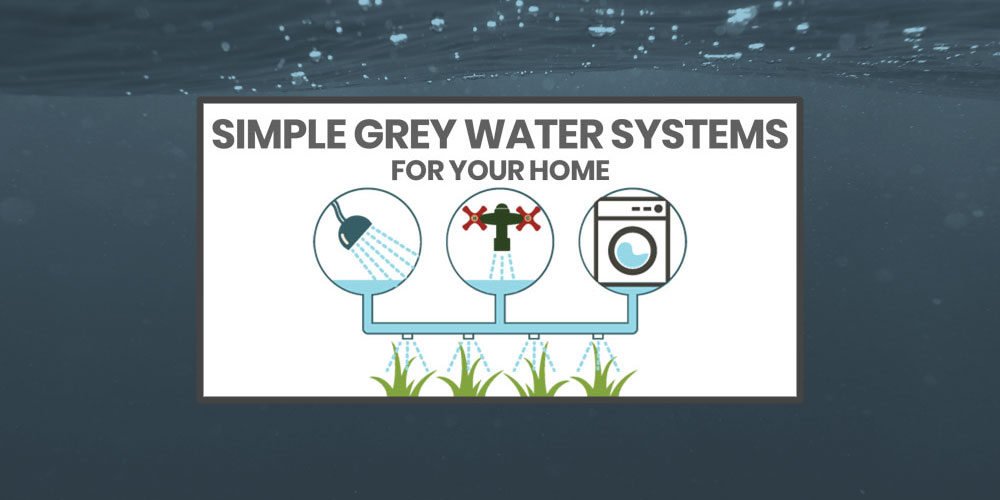
NAVIGATION
What are grey water systems and how can you set up a system for your home? Most people living in the average American household have no reason to contemplate disposal of the water that enters and leaves their homes, but more and more people are looking for a simple way to do a greywater system for their home.
What Is A Greywater System Used For?

A greywater system is used to take water that has already been used from places like your laundry, shower and sink and divert it to use in another purpose like watering gardens or landscaping instead of flushing it down into the sewer. Greywater is different from blackwater (aka sewage) because while it may have some residuals like dirt, hair, grease, etc from it’s first use, they aren’t toxic to the environment and the water can be reused in some applications.
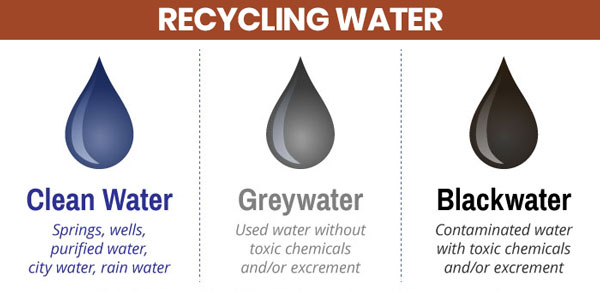
With greywater systems you are careful about what you put down your drain when diverting it to your garden or flower beds, but I’ve found that after your figure out some cleaning products that work for you, it’s quite simple.
How Do Grey Water Systems Work?

The concept is simple in principal: you want capture all the water from your sinks, showers and other drains into one place called a “surge tank” which is a fancy way of saying a tank that can take a lot of water at once and then slow down the flow. From there you want to allow the water to slow down just enough so any solids can settle out to the bottom and then let the cleaner water move on.
Grey Water System Diagram
In the below diagram you can see the basics of a system. You’ll see how the washer can be switched with a branched valve to either go to the sewer or the outside irrigation. The water then travels outside, into the garden and finally into drip points above mulch beds.
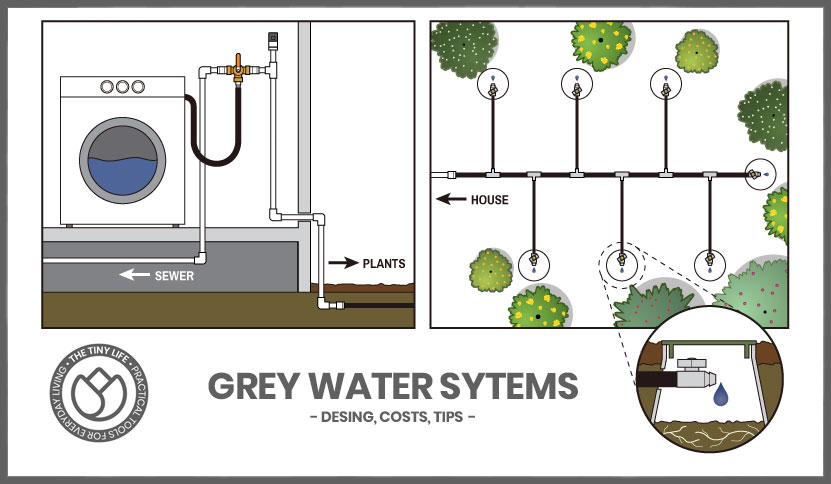
Our Simple Greywater Setup For Our Tiny House

I certainly had never considered such things until Cedric and I went volunteering on organic farms. In the south of Spain a small olive farm where water is scarce and they were watering their flower garden with the water from their sinks and showers. It was the first time I’d ever seen a greywater system in action. As aquifers run dry and water becomes a scarcer resource, I see the proper recycling of it essential to transitioning our treatment of water to a more sustainable system and tiny house dwellers are on the front lines of this transition.
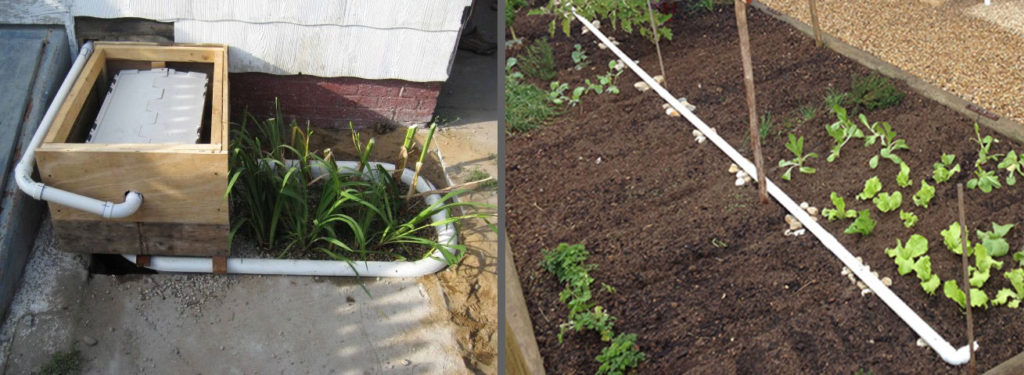
Living in a tiny house we have had to face the challenge of disposing our water safely since we weren’t hooked up to the city’s system. Our initial introduction at that farm inspired us to try a simple, DIY system that would use our greywater to irrigate a small garden.
We took 1 1/2″ pvc pipe, attached it to the plumbing of the house and buried it in the garden. Since we didn’t put in a filter we did not put any solids of any kind down the drain. We also carefully chose our bath soaps, used homemade shampoos and biodegradable dish soap so as not to damage the soil, plants or watershed. The PVC pipe was placed in a 2 foot deep ditch that had been lined with gravel and landscape fabric. Along the pipe we drilled many little holes to allow the water to escape. This technique is very similar to a french drain.
Are Grey Water Systems Legal?

Depending on your city, county and state you’ll have different rules that govern the use of greywater systems. Building codes, zoning laws and the public health department all come into play here, so develop a rough idea of what kind of greywater system you want to build and then have a conversation with your local city hall. Alternatively you can do this under the radar, but understand you assume all risk.
In some cases you’ll need to install a branched drain system so you can turn the greywater on and off based on what your use is.
How Much Does A Greywater System Cost To Install?

Installing a greywater system depends on your needs, how your plumping is setup in your house and how much of the work you’re going to do yourself. For a rough estimate you can plan on spending $500 to $2,500 to install a greywater system in your home. Most of the cost will be labor as the materials are cheap, but the labor can be expensive. Often it requires a plumber which can run between $50-$150 per hour and then someone to run ditches to your beds which can cost between $20-$75 per hour.
Common materials are PVC pipes, gravel, landscape fabric, a capture tank and plumbing fittings.
How To Design Your Grey Water System

Here are some of the key steps to consider for your grey water system design:
- Locate all your main drain points and plan how you will tap into each
- Determine where you’re going to drain your system to
- Check that your drains are at least 5 feet higher than your destination
- Mark where you are going to bury your drain lines with spray paint
- Install a valve at each drain sources or at the main drain pipe
- Pipe from valves to exterior of home
- Dig ditches below your frost line
- Fill bottom with 6 inches of loose gravel
- Place your drain lines and perforated lines and check all connections
- Cover pipes with another 4 inches of loose gravel
- Cover gravel with landscape fabric to prevent dirt clogging lines.
- Replace dirt or carry the gravel all the way to surface (best method)
Best Filtering Options For Grey Water

In some cases people will put a basic filter to screen out particles like food or hair mainly to prevent clogs in the rest of the system.Once the water is free of most of the larger debris, you can then pipe it underground to where you want to deposit it, making sure you spread out the volume of water over a large enough area to allow the soil to soak up the water quickly enough that it doesn’t get water logged.
You have a filter options:
- Filter bag before it enters into surge tank
- In line water filter
- Settling tank
- Constructed wetland or reed bed
- Setting pond or bog
Here are my two favorite ways to filter out grey water
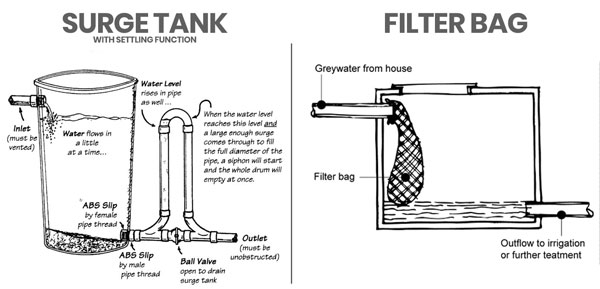
Tips For Your DIY Grey Water System

The biggest challenge people have when making their own system is getting your drain pipes clogged with food particles and hair from your drains. To combat that you want to employ two features in your system: a surge tank to settle out particles and a simple filter.
When the water from your drains comes from your house it’s carrying a lot of stuff like dirt, hair, skin cells, food particles and it’s moving pretty fast. We want to slow that water down and allow those things to settle out before moving on in the process. We don’t want that water to sit too long, no more than 24 hrs, but it’s a critical step.
From there we want to use a basic filter to grab any left over things that might be floating along. These don’t need to be a high grade filter that cleans the water, just enough to catch the particles big enough to clog things down the line.
The last tip I’ll give is make sure you consider how your drain lines will work in the winter. Freezing pipes can lead to major problems, so make sure your lines are draining to pipes buried below the frost line. You can consider putting in a valve at your branched piping inside so you can turn off this during the winter.
Grey Water Systems For Off Grid Living

Grey water is the perfect solution for dealing with waste water at your off grid home, cabin or tiny house. I use this on my off grid tiny home into a modified french drain system since I don’t produce much water waste to begin with. Don’t forget to pair your system with a rain catchment system to collect more water for your garden.
The biggest tips I can give you is to make sure your soil drains well, you can do this by doing a simple perk test (a water infiltration test) on your soil. If you soil drains well, figure out about how many gallons of grey water you will produce in a given day and design the system to handle that plus a 25% margin.
Make sure you plan it so your drain lines are down hill from your point of use, digging ditches deeper and deeper if you need to get a steep slope for proper drainage. Having the water move away from your house is critical, so make plans to drain at least 30 feet away to avoid moisture issues.
I wouldn’t spend time trying to figure out how to treat the grey water or how to make it drinkable, it’s better to use it effciently at the source, then repurpose it into your gardens for food production.
My Favorite Grey Water Friendly Products

When you make the switch to grey water, you’ll need to control what goes down your drain and that includes things like soaps, shampoo, cleaners and more. Anything that goes down the drain needs to be environmentally safe when it hits your garden.
Aubrey Men’s Stock Shampoo
This was the hardest item to find for me, a lot of shampoos that are grey water friendly don’t clean that well. Many shampoos left my hair looking greasy, but this one cleaned well and didn’t smell too “earthy”. The smell is pretty neutral, a minty smell that could easily be used by men or women. It’s a little pricey, but it’s the only thing that I found that actually works.
Amazon is the only place I’ve been able to find this Aubrey Men’s Stock Shampoo.
Dr. Bronner’s Pure-Castile Liquid Soap
This is an obvious and very popular option for those who want soap that is easy on the environment and just works well. Dr. Bronners is great for washing your hands, doing dishes, cleaning around the house, etc.
You can even bath with it and I found it to be good for body wash, but as I noted above, while it works for hair, it left my hair looking greasy. A lot of people use it as shampoo and it works well for them, so it’s worth a try. It’s also not terribly expensive and a little goes a long way.
This is where I get mine, click here.
Final Thoughts On Grey Water Systems
The majority of folks don’t think twice about these things and it’s wonderfully convenient to not have to. However, I’ve learned a lot about sustainable water practices by living with this system and I prefer it to sending this precious resource to a facility with black water where it becomes much more polluted and takes a lot of energy to introduce safely back in to the water cycle. It’s also a major plus for dry environments that see little rainfall and who at times must rely on their aquifers for water, as we experienced in Spain.
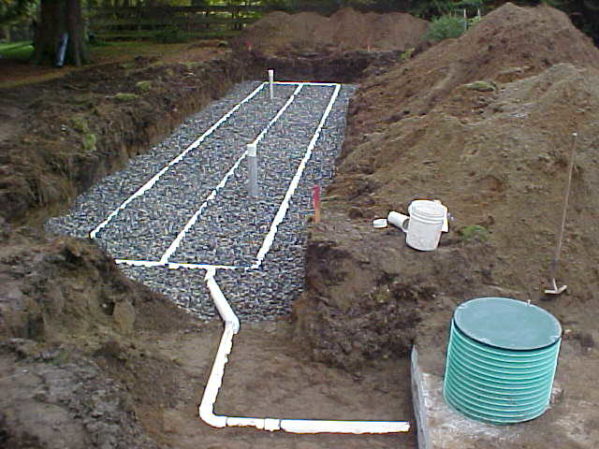
To sustain and maintain these deep fonts of water we need to replenish them. Allowing greywater to be filtered by plants back in to the ground recharges the aquifers and keeps them from drying out. The beauty of greywater systems is they can be incredible simple to construct, use and maintain. The collaborative group Greywater Action For A Sustainable Water Culture is an incredible resource not only for learning to construct and maint these systems, they also have a wealth of information on composting toilets, rainwater catchment and pedal-powered washing machines!
As we prepare to move La Casita once again, we plan to build a more elaborate system that can withstand the Vermont winters. The Greywater Action website also has great reviews of projects and useful tips for winterizing these systems. In the South it was much easier to manage it and although it will be more of a challenge it is another opportunity to learn and create a regenerative system. I’ll be posting details of our next greywater project so check-in with the tiny life over the next few weeks to see the details of construction!
Your Turn!
- Have any tips on water disposal in a tiny house?
- How do you feel about the current disposal and treatment of water?
- Do you think greywater systems are viable project towards changing how we think about water disposal?
 How Grey Water Systems Work
How Grey Water Systems Work Best Filtering Options
Best Filtering Options Off Grid Grey Water Systems
Off Grid Grey Water Systems Grey Water Friendly Products
Grey Water Friendly Products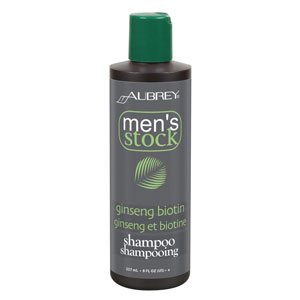
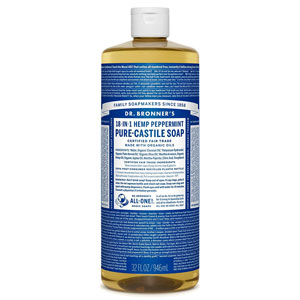
Fantastic link, thank you so much. The woodchip mulch basin is the pefect solution for my kitchen sink, much better than the dry well I was originally going to set up. Proper greywater disposal is a key element to managing our impact on the land and with a pond downhill from my place it’s doubly important to make sure nothing I do negatively affects the local groundwater. I don’t generate a consistently large enough greywater supply to maintain a pond system so simple DIY things that work at my level are good to find.
NOTE – the dugout pond downhill from me belongs to a farm next door, the pond I don’t have enough greywater for would have been a wetland greywater disposal at my place.
Getting ready to purchase property for my mini house. There are water and septic systems in place already, but looking at the grey water drain system you have here, it would be easy to go off the grid, at least as far as grey water is concerned…Do you use a composting toilet for the black?
I end up bringing this up every time this topic (wastewater/greywater /blackwater)comes up. I lived with a Sun Mar for several years, and switched to urine diverting toilet. The solid waste still gets composted, but it’s done outside. A much easier emptying situation – tie the biodegradable bag closed, snap on the lid, slide in the new bucket.
The best part for a small house is that it is easy to save the urine, which is great for a garden!
Composting toilet for black and we just keep dry and wet separate.
I have land and am putting a small (320 sf) cabin on it. It’s not hooked up to septic or county water yet, but it will be. Still, I want to recycle as much water as possible. I love the greywater systems and want to incorporate one into my plan somehow. I also plan to have rain barrels to catch all the water from the roof. The land is in an area where water isn’t generally a consideration (flooding is more of a concern) but why waste something so simple to recycle?
For those that don’t already have a septic system, you might consider a Watson Wick/Pumice Wick. It can be googled. There are substitutes for pumice if it’s not available in your area. Pay close attention to the size it needs to be scaled to projected water use. It uses grey and blackwater and you can grow any fruit or vegetable except root vegetables.
I am living in a Tiny House in which there is no plumbing in the walls. I fill a water crock with 2 1/2 gallons of water every night. During the day, the used water falls into a “sink” of a 6″ deep white recessed tub that I can lift out of the counter and pour into our gardens after each use. Since I only use Baking soda as a detergent (yes, I wash my hair and bath with it, and brush my teeth with it), and usually follow my baths with a vinegar rinse, the water has no chemicals at all that would harm my veggies, and you should see the happy garden! Another thing that really boosts my garden is saving the first morning urine (urine is sterile)in a container, mixing with grey water, and pouring it into the garden. This adds much needed nitrogen and helps in the composting of my toilet.
The belief that urine is sterile is a misunderstanding of a mid-19th century test for bladder infection. In fact, urine does contain bacteria, which are present everywhere in the human body (even our brains). Not all bacteria are bad, but when designing greywater systems, we need to be aware that our urine is not sterile.
This makes sense and I always wondered about it. If it’s sterile, logic would dictate that leaving it in a jug with a lid on would not result in any nasty smells. This, as we all know, is NOT the case. 😉
While only indirectly related to the issue of grey water disposal I’d like to remind people that you can do away with shampoo completely and therefore not have to worry about at least one potential contaminant.
Think about it. Shampooing is a totally man made action. We use a shampoo to wash all the natural oils out of our hair, then use a conditioner to put them all back in, only with some extra ylang ylang and essence of beaver nipple. Surely if we needed those things in our hair we would have them naturally? Of course we would, but we don’t.
I gave up using shampoo four years ago after having spent the first 39 years of my life fighting with either dandruff or greasy hair. There is an initial adaptation period of between 2 and 4 weeks where you hair may appear to be a little greasy while your body adapts to not having to restore the oils that were stripped out but once it regulates itself your hair becomes soft, shiny, full bodied and better than any shampoo has ever gotten it.
I wash my hair every morning when I have a shower the same way I did with the same actions as when I used shampoo only now its just shower water. No matter what I’ve been doing, playing soccer watching TV, mowing the lawn, water gets it perfectly clean. In fact, during the 39 years of my life nobody said anything about my hair, not surprising because I’m a guy and we don’t talk about such things, but since going ‘poo free a few people have commented and asked what I’m using. I’ve converted a few friends over the last few years, men and women, with hair long and short and those that have stuck out the initial period have all stuck with it ever since.
Give it a try, you might just surprise yourself, and reduce your greywater production in the process, not to mention saving all that ylang ylang and all those beavers 😉
Not even homemade soaps? Just plain water huh?….I have slowly using up the products I have on hand, believing that the minimialist approach will at least leave my footprint a little smaller…so will give this some thought as I phase out the junk. I have very long hair, and it’s as you say, either fighting dandruff or greasy hair…thanks for sharing!
I stopped using soaps on my body a couple of years ago…ever since then I have not had any problems with the dry winter itch that I used to get every winter! 🙂 I tried doing the baking soda and vinegar rinse on my hair but didn’t have good luck with that (I did it for over 6 months), so I went back to shampooing 2 times each week. I have never went with just water…I am willing to give it a try! Thanks for posting this.
I figure once I do get into my tiny home this will be a huge benefit to our water system!
Another side note: 1/3 c arrowroot powder, 1/3 c baking soda and 2 TBS coconut oil make a wonderful deodorant! 🙂 Been using for over 2 months and no one complains about any odor! 🙂
yes the baking soda and coconut oil is great i sued it after showering before going to work it last all day no sweat as well, and no funky odor.
I totally agree with you, just if you live inin a city you’re goingto needto rid your hair of diesel fumes etc… also brushing or combing help a lot ( think of animals that preen 4-8 times a day).
This is an excellent comment and makes perfect sense. I always wondered how the pioneers washed their hair before the invention of shampoo. I’ve tried the “no poo” as well with the baking soda with great results. Will use just water now. Thanks! I’ve also read daily showers mess up your skin mantle. Apparently, just washing the smelly bits is all you need to do which will result in much healthier skin.
We must remember that all these admonitions to wash our hair/shower every day, etc. are purely manmade piles of dung to make people buy more product. As Mark Twain said of statistics – “Lies, damn lies and, ________ I’ll insert “marketing” here as well.
We are taking it a step further and working on a platform to take grey water and make it potable – yes, actually processing the water and putting that water back into the house. We call is GREK 1.0 or Grey Water Recycling Experimentor Kit. We are looking for people to test this system and via open design hop to perfect the system. Imagine not needing a water company or well! Check it out at www.sanghaenergy.org.
Nice! I would definitely be interested in being a guinea pig!
www.sanghaenergy.org is no longer a working website. Have they possibly moved/changed names?? I am very much interested in water re-use. How can I contact you?
I myself often wondered why we are required to send all of our grey water to sewer processing plants or into a septic system. This water is perfectly safe, even with the soaps and shampoo, the ratio of water to soap causes the soap to be so diluted it doesnt cause a problem. Organic gardeners use soaps and oils to fight pest problems so this shows that these things do not effect the environment. Power to those who can think outside of the box, maybe we can save this world after all!
Living alone and not bathing daily due to extremely dry skin, I have a very simple method of using grey water: I just carry out the dishwater in a bucket and irrigate plants in the front yard.
Great article Andrea!
Have you seen Janaia and Robyn’s conversation on grey water? https://www.wordpress.peakmoment.tv/conversations/?p=270
Also, will Tammy and I get to meet you and Cedric at the yestermorrow event next weekend? 🙂
Cheers, L
Hi Logan! Thanks! I’m afraid I won’t be at the fair. I can’t afford it right now what with all the moving we’ve been doing and I contacted them to do a work trade but no one got back to me. It’s a shame…I’d love to be there! Thanks for the link!
What about winter? We are in Minnesota and need a grey water system for below freezing. Thoughts? Do we just need to dig it deeper?
Cold Water system for wintertime use, Do above in a tunnel Greenhouse and grow veggies there all year. Bury drums to hold water in below a sheltered frost level, or put insulation board around them to keep from freezing. These are basic ideas, will need you to build on them. Oh, and obviously your tunnel will want south sun exposure to keep it warm when sun is shining.
Would like instructions on how to make the grey water “box” in picture at beginning of this post. Thanks.
As a kid growing up in New Zealand I remember all the dish and bath water going on the vegetable garden in the summer, we were metered and droughts meant that you couldn’t waste water on plants so grey water was used. We were on mains water and sewage as we lived in the city but mum and dad were used to growing fruit and vegetables in the garden. Later dad worked in meat works (abattoir) and devised a system whereby all the waste water was reclaimed through an in-house sewage system (he was a world leader in sewage reclamation systems) and after cleaning – animal waste from both the pens and the killing/butchering areas – the sewage was turned into fertiliser and used to grow luxury crops like asparagus which added an extra income to the company. If people are interested I can probably find out more about the means he used, it was 30-40 years ago but would work just as well now.
My washer and dryer are located in the car port. I run the washer drain to my 100 year old oak trees. My btm bath tub and kitchen sink drain to my Mesquite trees out in the back yard. black water is two toilets and two btr sinks.
I moved to PA and am renting a little bit of someone’s backyard for my new TH. I just got through my first winter using a made-up system which worked perfectly! As it isn’t my own land, I wanted to make a small footprint so a long french drain wasn’t helpful and wouldn’t make it with below freezing temps. This is what I used: https://www.amazon.com/Aqua2use-Water-Filter-Garden-Landscape/dp/B0072JQYP2 (didn’t need the pump) connected with pvc pipes to https://www.lowes.com/pd/NDS-48-in-L-x-24-in-W-x-24-in-dia-Storm-Water-Leaching-System/3514920. Reasonably inexpensive and small foot print.
Sounds good to me, by experience I would say that some “ram rod” entries would be good (just in case). Using “Y” shaped connectors along the line and,possibly most important, a screw cap giving access to the end of the lines. Filtered or not some gunk will get there over the years and this would avoid digging it all up 😲.
Peter D.
I dont have a tiny house or raise anything food wise except herbs. I live in a 2-unit apartment bldg but have a generous patio for herbs and flowers. so you think it is okay to use, for instance, the water I rinse my dishes in (no dishwasher here) for my plants, assuming of course, I strain any chunky stuff that might be in there?
Don’t worry about the chunky stuff, it will degrade right on your plants, and they will love it
Thumbs up – Sharry is correct. The plants will love the small food particle in the rinse water.
I use my grey water from the sink after I scooped it in the bucket to water my indoor and outdoor plants. It works for me!
Yes the good and effective bucket routine – by far the most common way to use greywater. I have seen the kitchen sink diverted to a worm bin which is great. The worms get all the food scraps and the water is drain to a buck for “worm tea” that is then spread on the plants.
By far the majority of retrofits we advise homeowners on are from the greywater bucket brigade – who for year used a bucket to move the greywater. Then on the first bathroom or home remodel they have it diverted to the outside.
Greywater diversion is a great way to retirement proof the house. Lowering the water consumption and water bill at the same time.
Draining my bath water through burried pbc pipe. Do I need a P trap to slow down water flow from drain or is that just used to keep gases from septic at bay.
thinking about creating grey water system in my home, idea is to put big plastic holding tank in basement. pipe in shower drains to tank, run water through chlorine filter to kill bacteria. connect small pump to discharge this reclaimed water to separate line that only serves to fill toilets. use water twice before needing to go to septic drain system.
If you have a lawn or landscape using potable water, it would be just as beneficial to run all this water there instead of designing a toilet system.
What you describe I have seen used, but the system does not follow the plumbing code. The system i saw was on a cabin and the tank was empty daily to avoid the water going septic. Managing the chlorine was the cabin owners issue, that they decided to just use the greywater for the trees.
How much were you looking at when all said and done with your grey water system?
In the planning stage of building my own house and one of the things I’d like to achieve is to make it as ecologically sound and self sufficient as feasible, but I don’t feel the burning need to live entirely off grid as I telecommute.
We lose power at the property a lot, so planning for solar panels, putting in a masonry stove for primary heat and now trying to figure out how practical a greywater system would be for a garden/greenhouse. This site has definitely helped with that. Thanks for putting it out there for me to find!
Awesome post.
love this site…getting ready to live in a portable shed/conversion, I want a grey water system….reat information…thanks
Living in a cabin where nosy neighbors or inspectors are not an issue, the greywater system I used for 15 years was the following: regular plumbing pipes drained to a small (~2’x2′) shallow (1′ max) “pond.” That’s it. Never once did I have it overflow, and only a couple of times did it get noxious, usually when I used something like borax or tide in the laundry. If it got noxious I dug it out (very simple on something this small), threw the muddy gunk on the compost pile, and repopulated the bacteria with something handy that looked full of good bacterial– partially composted horse manure, rotted straw, whatever. The only occasional problem was freezing because the pipe under the house was not enclosed and the temps sometimes go to -30C.
I was looking at these,https://www.ebay.com/sch/i.html?_from=R40&_trksid=p2322090.m570.l1311&_nkw=grease+trap&_sacat
eBay has a whole page of them, stainless.
If my link doesn’t work just look up grease trap on eBay.
I didn’t have much luck dealing with the permit people in the past. They appear rigid and stuck on whatever was written long ago. They wanted a 1000 gallon septic tank for a small amount of greywater. I figure maybe 25 gallons a day, tops. Trees and landscapes would welcome this.
let’s find an alternative to AMAZON for the shampoo so that the idea of sustainability extends to the vendors that have equitable labor practices.
i’ll research that.
Useful info. Lucky me I found your site unintentionally, and I’m stunned why this twist of
fate didn’t came about in advance! I bookmarked it.
This was so helpful, thank you!
This really gave me some real good inside information about how to prevent pollution. Good article!⭐️⭐️⭐️⭐️⭐️
Exactly, it makes sense, especially in the west where it is so dry and water conservation is becoming more of an issue. It’s good to tap into tricks like this!
Estoy interesado en ese tema
Me gustaría saber mas
Even simpler: use your graywater for toilet flushes.
The simplest thing is to save your laundry water, and flush with a bucket. If you use a WonderWash for laundry, each cycle (wash and rinse) will use about 3-1/2 gallons of water: so drain the WonderWash into a 5-gallon bucket for each cycle. Then pour some of that water into a 2-gallon pail, filled to about 1-1/2 gallons, for each toilet flush. Wash + 2 rinses = about 11 gallons = about 7 flushes.
There are ways to make the whole thing invisible and automatic with a DC-powered pump and some switches, and make all of that code-compliant (disconnect the freshwater line from the toilet tank, connect up a graywater line from overhead water storage that can be mounted in the peak of the roof in an area not used for a loft). And, graywater from the shower can also be used.
Graywater containers _will_ develop soap scum film over time, and it’s a good idea to give them a decent scrub occasionally.
As it turns out, the water from laundry + shower balances fairly closely with water use in the toilet, so graywater flush will save about 20 to 30% of indoor water consumption.
To flush with a bucket: start by pouring the water in at the edge of the bowl to get the swirling action. Then very quickly pour most of the water right into the center to aid the siphon action when flushing poo.
Toilets that are prone to poo clogs when flushed conventionally, will clear completely without clogging if flushed this way, due to the added velocity of the water when poured in from about six to twelve inches above the bowl.
If you have visitors who aren’t also ecology hawks, you can use the bucket flush method yourself, and leave the fresh water connected to the toilet flush tank for guests’ use.
Thank you so much for the information. I learned a lot. This is so useful in saving our precious drinking water without needing all of those waste treatment facilities filling up with grey water. Unfortunately, many people who potentially would live in a place that uses this process cant be trusted to not use all the harsh detergents and chemicals that are on the market and commercially promoted. However, for those of us who are willing to learn and commit to being smart and environmentally responsible, this is a great option! I am going to utilize this in my next tiny house project.
Grey water is the wave of the future! I was wondering which water stocks you find innovative and if you invest in any particular company that is finding a solution to our future water shortage.
I don’t personally know yet of any companies. I called around to various plumbers at the beginning of this year to get a quote and they were all too booked with appointments to do “something like that.”
Interested in your grey water system
Hi. We live in New Zealand and have just moved into a tiny house on our property near the beach. We have a waterless composting toilet outside and pee into a camping toilet inside so only our poos go into the composting toilet. We have three source of grey water: shower, kitchen sink and shower room handbasin. They all drain into a common pipe that runs under the house to a large bucket (25 litres). Currently, I empty this into two 12 litre buckets and carry them to the veggie garden. I will do this one or two or three times a day depending on how much water we are using. We want to change this so that I do not carry buckets of water for the rest of my life (I’m 77 now). We like the ideas you have here on your website, but have just one questions. WHAT DO YOU USE FOR THE FILTER BAG? Thanks heaps. Cheers Norman.
There is too much water waste and too much going to the ocean only to become saltwater.
How do I deal with Grease?! I have trouble all the time and have had to dig up my system on several occasions over the years. I wipe my cookwear and plates before washing but eventually my system gets clogged.
For any concerns about grease, there’s woodchip filters. This site talks about them. https://greywateraction.org/woodchip-biofilter-for-kitchen-sink-wetlands/
Please refer me to a San
Diego area contractor who installs residential gray water systems. Thanks!
I wonder if a system like this could be used to capture water run-off from leaching fields?